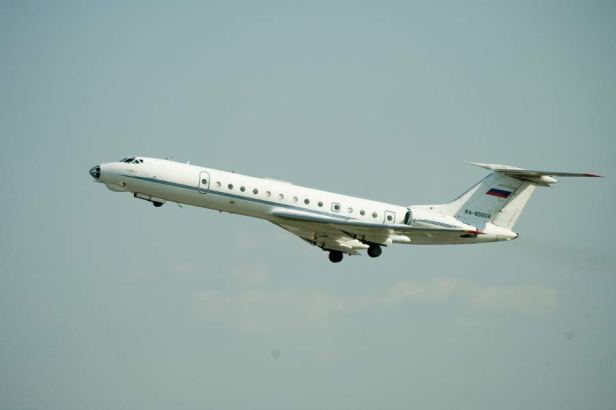 Tintin, Captain Haddock and professor Calculus accompanied by Snowy were flying to Sydney to attend the International Astronautical Congress aboard Qantas Flight 714. This is how the penultimate Tintin book got its name – “Flight 714”. At Jakarta airport they were introduced to Mr Carriedas, the billionaire who never laughed. Mr Carriedas developed a fancy for our friends and invited them to fly onboard his newest creation, the Carriedas 160. A triple jet executive aircraft which could fly to an altitude of 40,000 feet at a speed of Mach 2. Its Rolls Royce Turbomeca engines generated 18,500 lbs of thrust and the aircraft had swing wings for supersonic flight. The Carriedas 160 also carried a parachute for stopping quickly on landing. These parachutes were deployed in the book also. Though this aircraft was a pure figment of imagination, the characteristics, looks and wing mechanism closely related to a real aircraft of the time, the Soviet TU-134. I suppose the Carriedas was based on; or at least inspired by the TU-134, similarly as the limousine in “Tintin and the Picaros” was influenced by the ZIL 114.
Tintin, Captain Haddock and professor Calculus accompanied by Snowy were flying to Sydney to attend the International Astronautical Congress aboard Qantas Flight 714. This is how the penultimate Tintin book got its name – “Flight 714”. At Jakarta airport they were introduced to Mr Carriedas, the billionaire who never laughed. Mr Carriedas developed a fancy for our friends and invited them to fly onboard his newest creation, the Carriedas 160. A triple jet executive aircraft which could fly to an altitude of 40,000 feet at a speed of Mach 2. Its Rolls Royce Turbomeca engines generated 18,500 lbs of thrust and the aircraft had swing wings for supersonic flight. The Carriedas 160 also carried a parachute for stopping quickly on landing. These parachutes were deployed in the book also. Though this aircraft was a pure figment of imagination, the characteristics, looks and wing mechanism closely related to a real aircraft of the time, the Soviet TU-134. I suppose the Carriedas was based on; or at least inspired by the TU-134, similarly as the limousine in “Tintin and the Picaros” was influenced by the ZIL 114.

The Carriedas 160 has an uncanny similarity to the TU-134 physically. The fuselage, wing and engine arrangement and the stabiliser and elevator are same as that of the TU-134. So, what was the TU-134. It was a short haul passenger aircraft manufactured in the Soviet Union by Kharkov State Aircraft Manufacturing Company and designed by Tupolev. This aircraft replaced the TU-124 and was a very popular short haul aircraft in the Eastern Bloc. Around 854 of these aircraft were manufactured between 1966 and 1989. They were adopted by 26 countries and were the primary short haul aircraft in the Soviet sphere of influence. These aircraft were frequently used across Europe till western Europe came up with standards to minimise sound from aircraft. Though phased out progressively since the early 90s, some of them can still be seen in service in countries like North Korea and Syria. Several of these aircraft were modified into trainer aircraft for Soviet bomber crews, for training cosmonauts and also in the Soviet space shuttle programme.
The initial aircraft, based on the TU-124 had a glazed glass cockpit as they used a navigator. However, with the development of technology and the introduction of radars, the later aircraft were provided with a solid nose cone like any other modern aircraft.

The TU-134 had a crew of 5 and could carry 76 passengers. This aircraft, like Carriedas 160 had two turbofan engines mounted at the rear of the aircraft. It has a flight ceiling of 39,698 feet, very close to the 40,000 feet ceiling of Carriedas 160. Its two Soloviev D-30-II engines generated 15,000 lbs thrust each pushing the aircraft to a top speed of 590 mph, much slower than 1,250 mph of the Carriedas 160. The TU-134 was 37.1 m (121.72 ft) long, the fuselage diameter was 2.9 m (9.51 ft), the aircraft width including wingspan was 29 m (95.14 ft) and its height was 9.02 m (29.53 ft). An empty TU-134 weighed 28 tons (61,729 lbs) while it had a payload capacity of 8.2 tons. With its fuel tanks full and a full payload of crew and passengers, the TU-134 could cover 2,380 km (1478 miles). It was one of the few passenger aircraft in the world which used a parachute for stopping after landing.
Within Soviet Union and later Russia, the TU-134 was the most popular and common short haul aircraft which connected faraway portions of the vast country.

